Strategic Management Assignment: Self-Reflection on Implication of Leadership Development
Question
Task: The Strategic Management AssignmentTasks: Building on the leadership development mapping tool you were introduced to in the seminars, write a self-reflective report on the implications of the theoretical frameworks and practical skills learned on the module to your personal leadership development plan.
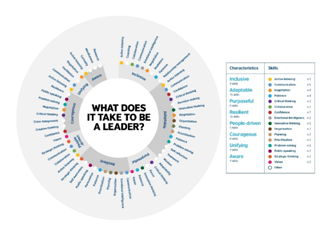
Structure the answer to explore the three following elements:<
a) Self- acceptance: reflect on your personality leadership preferences and style according to the Big Five Personality Test (covered in seminar 11). What is personality style How accurately this style describes you What are the main advantages and struggles you might have following this style
b) Self-management and leadership: what characteristics do you want to develop and why (choose the 3 most important for you)
c) Self-development: Choose maximum 3 frameworks/models and reflect on the frameworks and models of Strategic management and Leadership you studied on the module (benefits and drawbacks). How the new knowledge and skills from these frameworks/models will help you in your personal and professional development
Answer
Introduction
This has been evident within the present aspect of strategic management assignmentthat personal and professional development have become essential for graduating students to enhance their employability in the future career. It has become important for achieving various skills, understanding, knowledge and personal attributes that can help in increasing the probability of gaining employment opportunities in the professional market (Hicks, et al., 2014). While personal development is required for catering to the innate human need for growth and reaching full potential, professional development focuses on continuous learning and acquiring new knowledge, skills and experience for reaching career goals.Both these help individuals in setting their goals, assessing and learning new skills and developing individual qualities (Hicks, et al., 2014). The purpose of the report here is to develop a self-reflection on key strategic management and leadership areas, by focusing on self-acceptance, self-management and leadership and self-development. In this regard, various models and frameworks have also been reviewed for understanding their contribution towards individual life.
Self-acceptance
It is of utmost importance to provide emphasis on self-acceptance as it will help me to enhance my personal and professional development. For this purpose, I first need to understand my personality style for developing strengths, skills, knowledge and competencies to acquire employability. Personality can be referred to as the characteristic patterns of different thoughts, behaviours and feelings arising from within an individual and remaining consistent throughout the life (Kernberg, 2016). In this regard, I have undertaken the Big Five Personality Traits Test for identifying my personality style. These five traits include openness to experience, extraversion, conscientiousness, agreeableness and neuroticism (Sori, Penezi and Buri, 2017).
Fig 1: Big Five Personality Traits
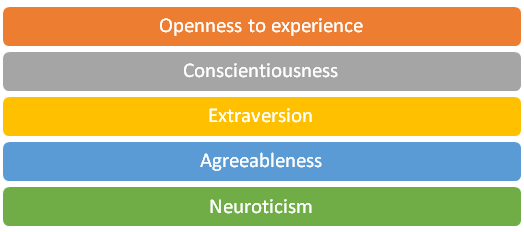
From the test results, I have identified my scores in each of these traits. While I have scored higher in neuroticism, conscientiousness and agreeableness, while low in extroversion and openness to experience (Appendix 1). Neuroticism is characterized by moodiness, emotional instability and sadness. Scoring high in this trait shows that I often experience mood swings, anxiety, sadness and irritability, which can be harmful for my personal and professional life (Bui, 2017). This is because low emotional instability can make it difficult for me to deal with difficult situations in my personal life. Furthermore, I can also face problems while working in my professional career with emotional instability and moodiness, which might lead to conflicts with my peers. However, with high conscientiousness, I have the ability to observe minute details, finish tasks on time and spend considerable time for preparation to avoid failures (Byrne, Silasi-Mansatand Worthy, 2015). This shows my expertise of being organized and mindful of details that can be beneficial in my professional career for successful implementation of plans and achieving desired goals. However, it also shows that I might face troubles in uncertain situations where I do not get ample time for preparation. Besides, my high score in agreeableness shows that I am more cooperative with others and have the ability of empathising, helping others and caring about my peers (Sori, Penezi and Buri, 2017). This trait will be beneficial for me to build social relationships and further work efficiently in a team. I will also be able to resolve conflicts with team members in the professional situation. On the other hand, the low score in extraversion shows my reserved and introvert personality style (Appendix 1). This will be beneficial for me in completing various analytical and problem-solving tasks as I put a lot of thinking before undertaking any decision (Byrne, Silasi-Mansatand Worthy, 2015). However, it might also become problematic for me in building relationships with my superiors, peers and clients at the workplace. Thus, I need to practice socializing with others for working better in teams and groups in the future. Moreover, I have also scored low in openness to experience, which makes it essential for me to become more embracing towards new ideas and change (Bui, 2017). My lack of ability to imagine, accept new ideas or enjoy new things might become troublesome while working in a company as businesses are often faced with uncertain or unpredictable situations. In these situations, thinking out of the box and deviating from normal schedule becomes necessary.
Self-management and leadership
Self-management is one of the most important elements of emotional intelligence (Quinteiro, Passosand Curral, 2016). It is important for me to able to manage my own emotions, thoughts and feelings by becoming more self-aware. This will enable me to emerge as a successful leader by managing my own emotions alongside empathizing with subordinates. Some of the abilities underlying this self-management include self-control, conscientiousness, adaptability, trustworthiness, initiative and achievement orientation (Quinteiro, Passosand Curral, 2016). In this regard, the three most important characteristics that I need to develop for enhancing my leadership abilities are self-control, adaptability and trustworthiness.
Fig 2: Three Characteristics to Develop
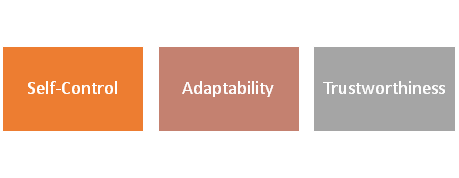
From the Big Five Personality Traits Test, it has been observed that I have scored high in neuroticism, which shows the lack of emotional stability present in my personality (Appendix 1). This makes it essential for me to develop the characteristic of self-control for being able to manage my own emotions. The first step of self-control for me will be to recognize my emotions and understand how they influence my thoughts and actions (Müllerand Niessen, 2018). Here, I need to further comprehend how my emotions relate to individual experience and values. The ability to recognize emotions and their effect will make it easier for me to control them. In this regard, I also need to explore the causes for controlling the emotions. Besides, it is also important here to understand that my negative emotions might be because of preconceived beliefs and notions about myself, others and the world. Such comprehension will help me to better manage my emotions and enhance the emotional intelligence.
Furthermore, I also scored less in openness to experience, which can make it difficult for me to adapt to unpredictable situations that are common in professional and business environment (Appendix 1). Change in inevitable in professional career and leaders are required to be more flexible for succeeding in these situations (Dubey, Singhand Gupta, 2015). I need to develop more flexible ways of thinking for being adaptable to surrounding environment. This will help me to become more responsive towards external changes and operate successfully in the professional career. I can further enhance my adaptability through building more resilience when things become unplanned or do not go as predicted. Such agility and resilience will enable me to undertake effective decisions despite changes or uncertainties present in the situation. Thus, I can be more embracing towards new experiences through developing adaptability skills.
In addition, I will focus on developing trustworthiness for being more sociable and extraverted in both personal and professional life. It is essential for me to build relationships with colleagues, peers, subordinates and supervisors in the company that I start working. Besides, I also need to have networking with other industry professionals to gain better employment opportunities (Kim and Kuo, 2015). For this purpose, I will work on being more trustworthy so that these people can rely and depend on me. I will also be able to confront individuals in the professional field who takes unethical actions and further develop my own character through honesty and integrity in the professional field. Thus, I will focus on developing self-control, adaptability and trustworthiness skills.
Self-development
I came across various theories and frameworks during my course of strategic management and leadership. These models or frameworks are of great significance in understanding own abilities or applying them in an organizational context. Out of these SWOT analysis tool in strategic management and leadership theories like Fiedler’s Contingency Model and Goleman’s Six Leadership Styles have been gained my interest.
SWOT Analysis Tool
Fig 3: SWOT Analysis Framework/Model
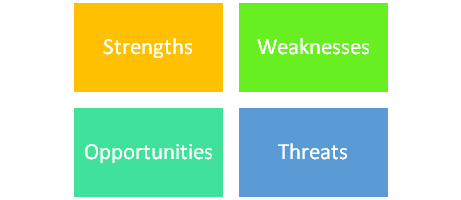
SWOT is a strategic analytical tool that helps in analysing the external and internal factors. While these internal factors can be controlled, the external factors of the environment are beyond the control of individuals. This tool is useful for identifying strengths, weaknesses, opportunities and threats of an environment. SWOT analysis has emerged as one of the most popular tools for evaluating and understanding strategic position of a firm in the business environment (Phadermrod, Crowderand Wills, 2019). It has been useful for analysing the internal potential and limitations of any business, group or individual and further identifying any probable threats and opportunities present in the external environment. Thus, it can be regarded as the source of information for any strategic planning, overcoming weaknesses, using strengths, maximizing opportunities and responding to threats. However, despite these benefits, there are certain limitations associated with this tool. These include inability to control external environment like economic downturn, price increases, government legislation. In addition, it only provides generalized information about the environment. SWOT tool can be beneficial for my own personal and professional development. I can identify strengths and weaknesses of my personality and work on the areas of improvement from this tool. Besides, I can also identify professional opportunities and threats like intense competition, lack of employability and others for enhancing my professional development.
Fiedler’s Contingency Model
Fiedler’s Contingency Model is one of the most important leadership theories focusing on various situational variables for understanding leadership effectiveness. The three situational variables present here include task structure, leader-member relations and leader’s position power (Nastiezaieand Musavinejad, 2018). Based on these variables, the model provides two leadership styles, namely, task-oriented and relationship-oriented. While task-oriented leaders focus more on organizing teams and projects for achieving the desired results and completing the tasks, relationship-oriented leaders emphasize on developing relationships with their subordinates and amongst team members for managing conflicts.
Fig 4: Fiedler’s Contingency Theory
(Source: Sivaruban, 2021)
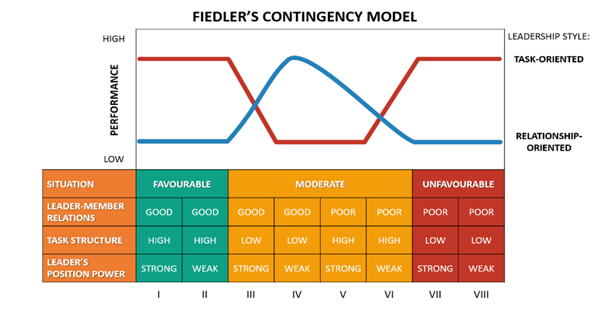
This model is useful for identifying leaders in a simple way and takes into consideration situational variables unlike many leadership theories for determining leadership effectiveness. However, this model is inflexible as it only considers three situational variables as opposed to various factors influencing leadership approach and decision (Sivaruban, 2021). Besides, the scale of measurement is subjective, thereby increasing the chance of error in assessing the leadership effectiveness.
However, I can use this model for identifying my own leadership style based on task or relationship orientation. Based on such analysis, I can develop or improve my leadership skills, which will help me in my future career.
Goleman’s Six Leadership Styles
This model or framework provides the presence of six leadership styles, namely, coercive, authoritative, affiliative, democratic, pacesetting and coaching. Goleman’s leadership styles framework has been useful in identifying leadership effectiveness based on the approach and conditions unlike the Fielder’s Contingency Model. It is easier to identify the leadership style of an individual with the help of this model and further understand the underlying conditions of using such approach (Saxena, et al., 2017). Besides, this model has also broadened the perspective and options of associating own personality with any six of the leadership styles.
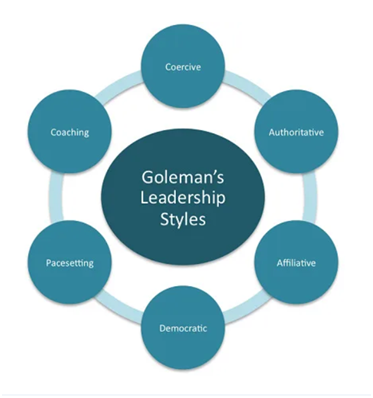
Fig 5: Goleman’s Six Leadership Styles
(Source: Goleman, 2017)
This leadership model limits itself to specific
leadership style and does not consider the influence of any external variables on the leadership effectiveness. The model further becomes difficult in application as one has to become emotionally aware about their strengths and weaknesses alongside external challenges to identify which leadership style will work best. This indicates that it will be helpful for me to analyse the different types of approaches that I can undertake in the future and accordingly, develop my own skills and competencies to become a particular type of leader. However, I might face difficulties in understanding how this style will vary based on situations under this leadership framework.
Conclusion
The self-reflective report focused on understanding the relevance of various concepts and theories of strategic management and leadership that can influence my personal and professional development. I carried out the Big Five Personality Traits Test for identifying my personality style. This helped me to identify my shortcomings and weaknesses. In this next section, I focused on improving three characteristics that seemed to be most important for leadership development, namely, self-control, adaptability and trustworthiness. In the third section of the report, I analysed three theoretical frameworks of SWOT tool, Fiedler’s Contingency Model and Goleman’s Six Leadership Styles and their influence on my future development.
Reference List
Bui, H.T., 2017. Big Five personality traits and job satisfaction: Evidence from a national sample. Journal of General Management, 42(3), pp.21-30.
Byrne, K.A., Silasi-Mansat, C.D. and Worthy, D.A., 2015. Who chokes under pressure The Big Five personality traits and decision-making under pressure.Personality and individual differences, 74, pp.22-28.
Dubey, R., Singh, T. and Gupta, O.K., 2015. Impact of agility, adaptability and alignment on humanitarian logistics performance: mediating effect of leadership. Global Business Review, 16(5), pp.812-831. Goleman, D., 2017. Leadership that gets results (Harvard business review classics). Harvard Business Press.
Hicks, P.J., Schumacher, D., Guralnick, S., Carraccio, C. and Burke, A.E., 2014. Domain of competence: personal and professional development. Academic pediatrics, 14(2), pp.S80-S97.
Kernberg, O.F., 2016. What is personality.Journal of Personality Disorders, 30(2), pp.145-156. Kim, S. and Kuo, M.H., 2015.Examining the relationships among coaching, trustworthiness, and role behaviors: A social exchange perspective.The Journal of Applied Behavioral Science, 51(2), pp.152-176. Müller, T. and Niessen, C., 2018.Self-leadership and self-control strength in the work context.Journal of Managerial Psychology, 33(1), pp. 74-92. Nastiezaie, N. and Musavinejad, S.H., 2018. Predicting the effectiveness of school principals based on fiedler’s leadership model. The New Educational Review, 51(1), pp.184-191.
Phadermrod, B., Crowder, R.M. and Wills, G.B., 2019. Importance-performance analysis based SWOT analysis. Strategic management assignmentInternational Journal of Information Management, 44, pp.194-203. Quinteiro, P.M., Passos, A. and Curral, L., 2016.Thought self-leadership and effectiveness in self-management teams.Leadership, 12(1), pp.110-126. Saxena, A., Desanghere, L., Stobart, K. and Walker, K., 2017. Goleman’s leadership styles at different hierarchical levels in medical education. BMC medical education, 17(1), pp.1-9.
Sivaruban, S., 2021.A Critical Perspective of Leadership Theories.Business Ethics and Leadership, 5(1), pp.57-65.
Sori, I., Penezi, Z. and Buri, I., 2017. The Big Five personality traits, goal orientations, and academic achievement.Learning and individual differences, 54, pp.126-134.
Appendix
Appendix 1: Big Five Personality Test













